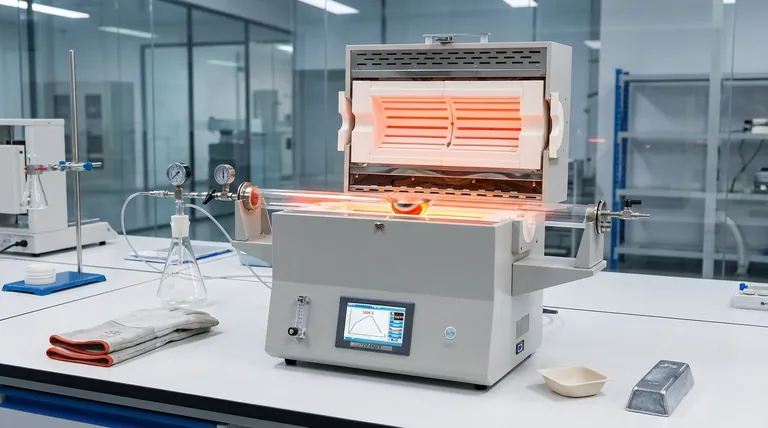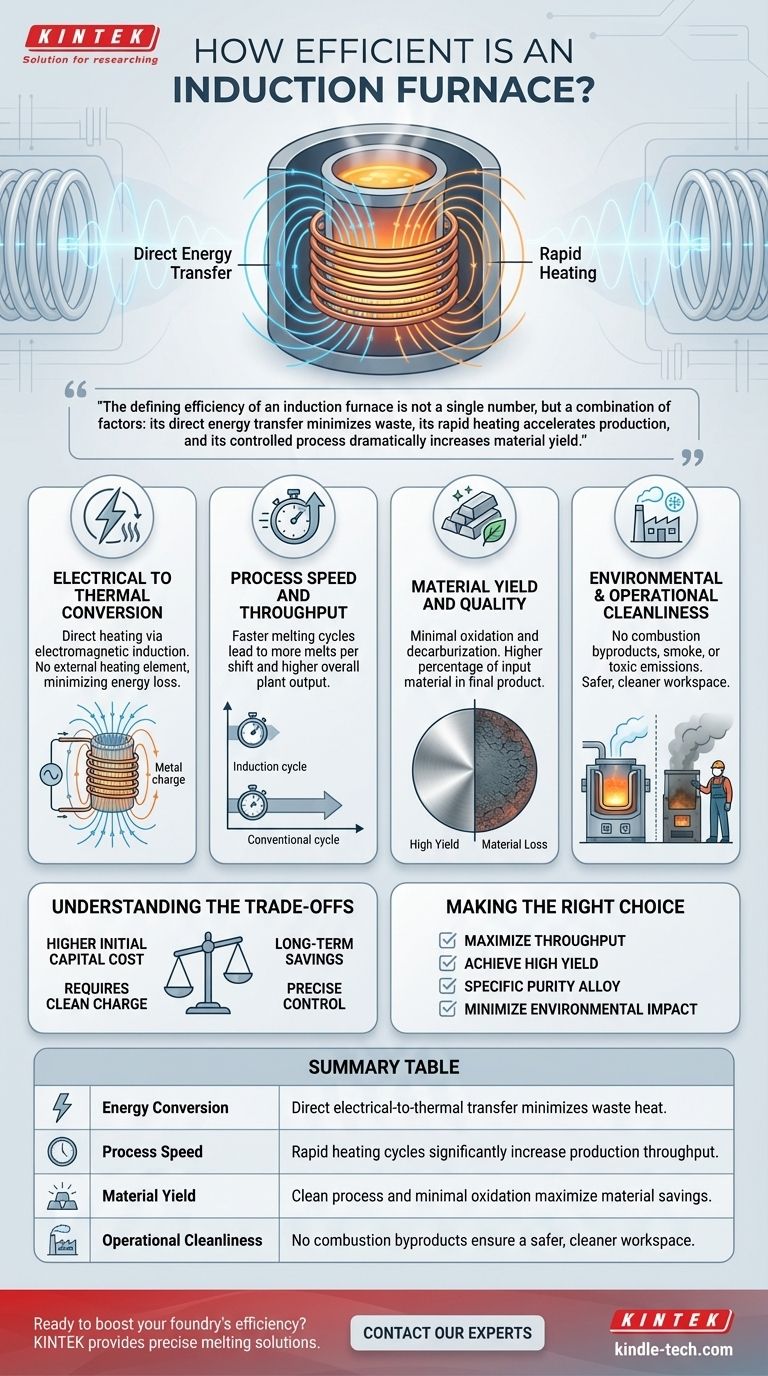At its core, an induction furnace is exceptionally efficient, but its true value is measured in more than just energy consumption. True efficiency in a production environment encompasses energy conversion, process speed, material conservation, and operational cleanliness. The induction furnace excels across all of these dimensions.
The defining efficiency of an induction furnace is not a single number, but a combination of factors: its direct energy transfer minimizes waste, its rapid heating accelerates production, and its controlled process dramatically increases material yield.

Deconstructing "Efficiency": Beyond Energy Use
To properly evaluate an induction furnace, we must look at efficiency from four distinct angles. The technology's design provides compounding benefits in each area.
Electrical to Thermal Conversion
The fundamental principle of an induction furnace is its direct heating method. An alternating current is passed through a water-cooled copper coil.
This creates a powerful, rapidly alternating magnetic field that couples with the metallic material (the "charge") inside the crucible. This magnetic field induces eddy currents within the metal itself, generating intense heat precisely where it's needed.
Because there is no external heating element and no need to heat the surrounding air or furnace chamber first, the transfer of electrical energy into thermal energy is remarkably direct and efficient.
Process Speed and Throughput
The fast heating speed mentioned in production analysis is a direct result of this efficient energy transfer.
Melting cycles are significantly shorter compared to many traditional fuel-fired furnaces. This speed is not just a convenience; it is a direct driver of production efficiency, allowing for more melts per shift and higher overall plant throughput.
Material Yield and Quality
In conventional furnaces, the metal charge is exposed to the products of combustion and open air, leading to significant material loss through oxidation (scaling).
Induction heating is a clean process with no combustion byproducts. The speed of the melt also minimizes the time the hot metal is exposed to air, drastically reducing oxidation losses.
This means more of your input material ends up in the final product, directly saving material costs. Furthermore, it prevents decarburization (loss of carbon from the steel's surface), which preserves the metallurgical integrity of the alloy and reduces part rejection rates.
Environmental and Operational Cleanliness
An induction furnace produces no smoke, ash, or toxic emissions, as it does not burn fuel. This makes it an environmentally clean technology that simplifies regulatory compliance.
Operationally, the process is contained and far less messy than traditional methods. This improves workplace safety and reduces the time and cost associated with cleanup and maintenance.
Understanding the Trade-offs
No technology is without its compromises. A clear-eyed assessment requires acknowledging the limitations of induction melting.
Higher Initial Capital Cost
Induction furnace systems are technologically sophisticated and generally require a higher upfront investment compared to simpler furnace types like cupolas. The cost-benefit analysis must weigh this initial capital expenditure against long-term operational savings.
Requirement for a "Clean" Charge
Induction furnaces perform best with relatively clean and dry scrap metal. Excessive dirt, oil, rust, or moisture on the charge material can introduce impurities and cause dangerous splashing or gas evolution during the melt.
Limited Metallurgical Refining
Unlike an Electric Arc Furnace (EAF), a standard induction furnace offers very limited capability for metallurgical refining. It is primarily a remelting device. The chemical composition of the final product is almost entirely determined by the materials you put in; elements like sulfur and phosphorus cannot be easily removed.
Making the Right Choice for Your Operation
The decision to use an induction furnace should be based on a clear understanding of your primary operational goals.
- If your primary focus is maximizing production throughput: The rapid heating cycles of an induction furnace are its greatest asset, directly translating to more melts per shift.
- If your primary focus is achieving high material yield and quality: The minimal oxidation and decarburization inherent to the process will save significant material and reduce reject rates.
- If your primary focus is a specific, high-purity alloy: The clean, contained melting process ensures precise control over the final composition, provided you start with a known input charge.
- If your primary focus is minimizing environmental impact: The lack of combustion byproducts makes the induction furnace the cleanest melting technology available for foundries.
Ultimately, understanding these distinct dimensions of efficiency empowers you to select the right melting technology for your specific industrial goal.
Summary Table:
| Efficiency Dimension | Key Benefit of Induction Furnace |
|---|---|
| Energy Conversion | Direct electrical-to-thermal transfer minimizes waste heat. |
| Process Speed | Rapid heating cycles significantly increase production throughput. |
| Material Yield | Clean process and minimal oxidation maximize material savings. |
| Operational Cleanliness | No combustion byproducts ensure a safer, cleaner workspace. |
Ready to boost your foundry's efficiency? The right induction furnace can transform your operations by increasing throughput, improving material yield, and ensuring a cleaner process. KINTEK specializes in high-performance lab equipment and consumables, providing the precise melting solutions laboratories and foundries need to excel. Contact our experts today to discuss how an induction furnace can meet your specific production goals!
Visual Guide

Related Products
- 1400℃ Laboratory Quartz Tube Furnace with Alumina Tube Tubular Furnace
- 600T Vacuum Induction Hot Press Furnace for Heat Treat and Sintering
- Lab-Scale Vacuum Induction Melting Furnace
- Vacuum Heat Treat Furnace and Levitation Induction Melting Furnace
- 1700℃ Laboratory Quartz Tube Furnace with Alumina Tube Tubular Furnace
People Also Ask
- What materials are used for the tubes in tube furnaces? A Guide to Selecting the Right Tube for Your Process
- How does a tubular furnace work? A Guide to Controlled High-Temperature Processing
- What is the high temperature of a tube furnace? Unlock the Right Model for Your Application
- What are the advantages of a tube furnace? Achieve Superior Temperature Uniformity and Control
- What are the benefits of a tube furnace? Achieve Superior Temperature & Atmosphere Control



















